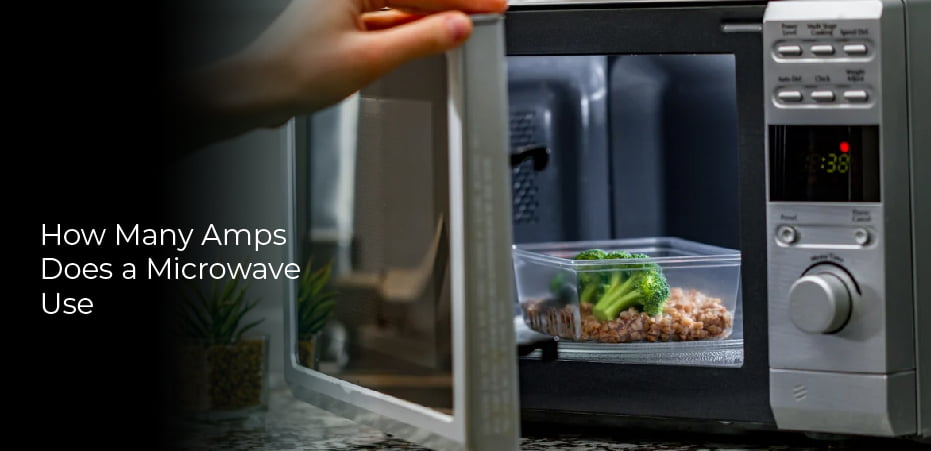How many amps does a microwave use: If you are looking to purchase a microwave, it’s important to know how much power it will use. If you aren’t sure, look at your home’s electrical circuits and see how much wattage they can handle. A low-wattage microwave can be a great choice, and you can also look for ENERGY STAR certification.
CALCULATE AMPS FROM WATTS
To calculate the amps from watts, simply divide the wattage rating by the voltage rating. For example, if a 1,000-watt microwave runs on 120 volts, it will be drawing 8.33 Amps of current (1,000 / 120 = 8.33).
What Is An Amp As It Relates To Power?
An Amp (or Ampere) is a unit of electrical current. It tells you how much electricity is flowing through the wires of your appliance or device at any given moment. How many amps a microwave use depends on the wattage, voltage ratings, and other factors.
For example, if a 1,000-watt microwave is running on 120 volts, then it will be drawing 8.33 Amps of current. On the other hand, if the same 1,000-watt microwave is running on 240 volts, then it only needs to draw 4.17 amps of current. The higher voltage reduces the amount of electrical current needed for a given appliance to run.
Why Do Microwaves Trip Circuit Breakers?
A circuit breaker will trip if the amount of current being drawn by a device like a microwave exceeds the breaker’s capacity. This could be due to an overload or short circuit. Surge protectors are designed to absorb sudden spikes in voltage and protect against power surges that may cause damage to your appliances. A surge protector does not necessarily prevent a circuit breaker from tripping but can reduce the likelihood of an overload or short circuit.
How Many Watts/Amps Does A Microwave Use?
The wattage of a microwave will depend on the model and size. Generally, microwaves range from 600 to 1800 watts. The higher the wattage, the more power is required to run it. To calculate the amperage required for your specific microwave model, you need to know both the voltage and wattage ratings. For example, a 1,000-watt microwave running on 120 volts will require 8.33 Amps of current.
Low& High – Wattage Microwaves
Low-Wattage Microwave
A low-wattage microwave can be an attractive option. It offers many advantages and can be useful for people who do not need a microwave to heat large meals. They can be plugged into an extension cord and are compatible with most outlets. However, they also may have downsides.
One disadvantage is that they take longer to cook food. This can be a problem for those who do not like their food to turn out right. Luckily, there are other ways to ensure you get the best results out of your appliance.
You should also read the owner’s manual to ensure you know how much power your new microwave uses. Some models have several settings, which can make it difficult to calculate exactly how much power you’re using.
High-Wattage Microwaves
The wattage of a microwave is the amount of electricity it uses. High-wattage microwaves will usually have wattages between 1000 and 1800 watts, although some can go up to 2000 or more. These high-wattage microwaves will require more amps than standard microwaves to run, so it is important to ensure your electrical system can handle the additional amps.
Additionally, it is important to ensure that you have a surge protector or a circuit breaker in place so your microwave won’t cause an overload and trip your circuit breaker.
ENERGY STAR Certification
ENERGY STAR certification for microwave amps is a sign of a product that has been tested and proven energy efficient. This program is created by the Environmental Protection Agency (EPA) and the Department of Energy (DOE). It was established in 1992 to promote the use of energy-efficient products. It also provides incentives for emerging technology solutions.
Energy Star products save money on energy bills, protect the environment, and help reduce greenhouse gas emissions. Choosing an appliance with an ENERGY STAR label can make a huge difference in your life. However, an appliance must meet stringent energy efficiency standards to qualify for ENERGY STAR certification. The criteria include energy savings, features that consumers want, and high-performance standards.
When shopping for a new appliance, look for a yellow ENERGY STAR label. This makes it easy to identify energy-efficient appliances. You can use the Energy Savers website to learn more about the ENERGY STAR standards for different appliances.


